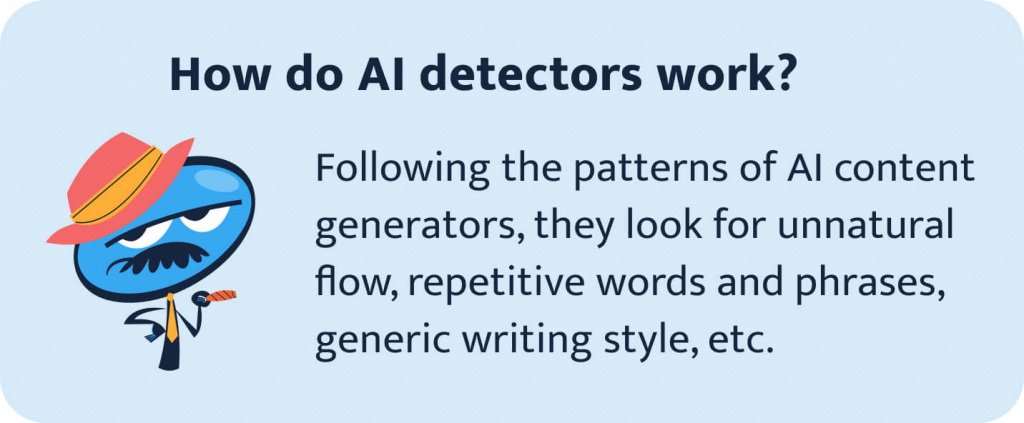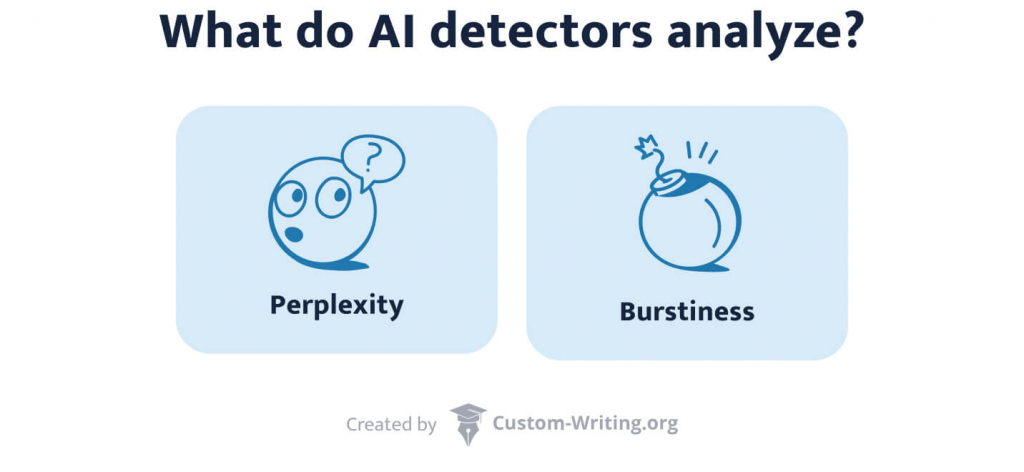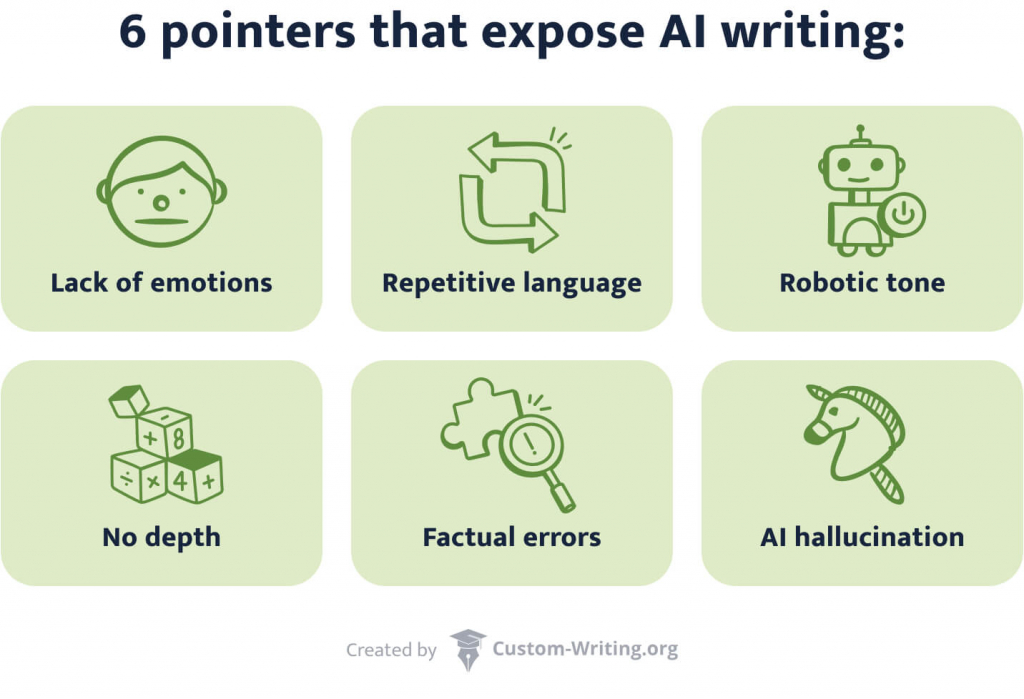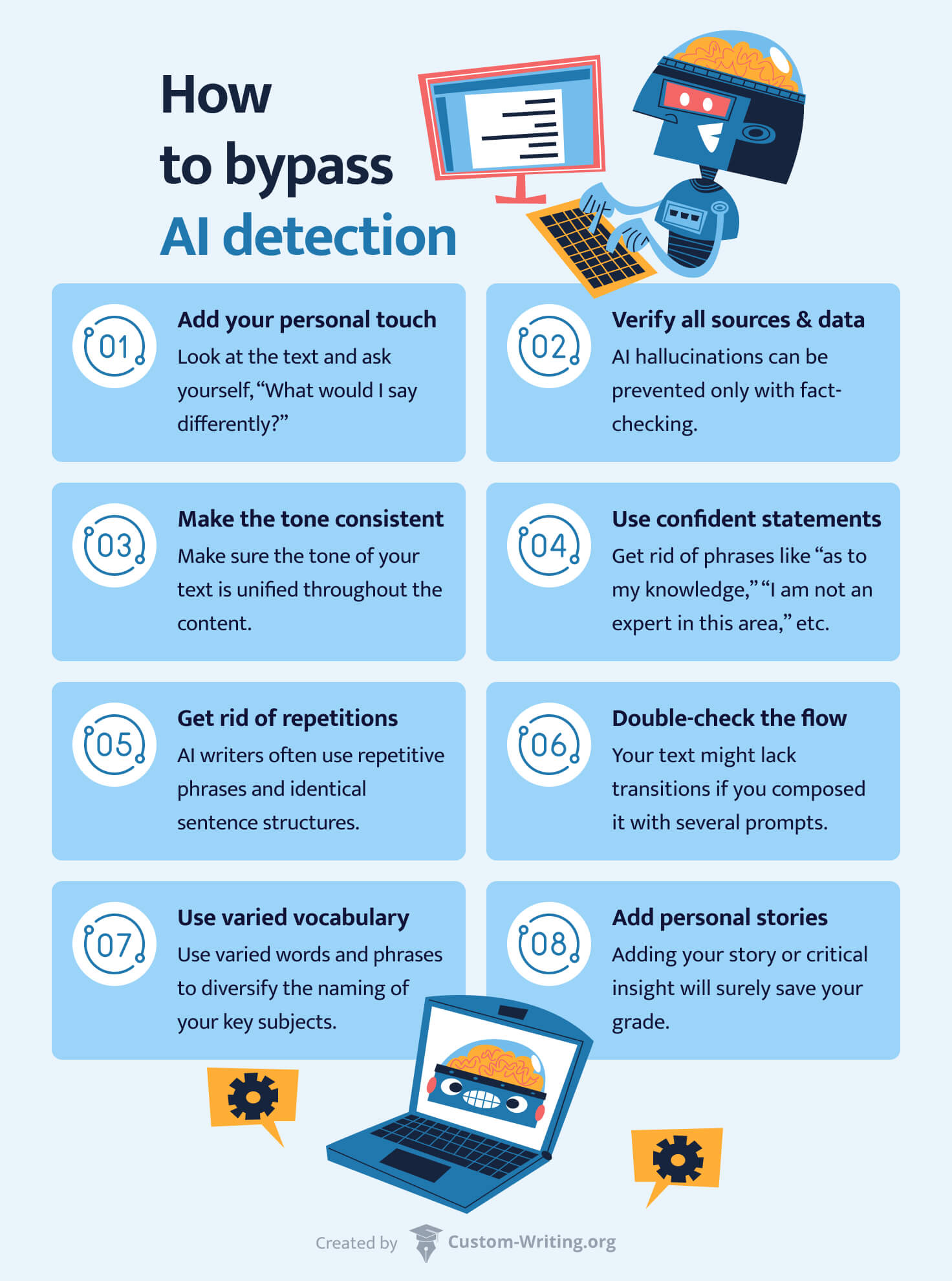AI is entering our lives with a bang, changing things we’re used to and introducing the new normal. With the advent of ChatGPT, content generation has reached an entirely new level of sophistication. What used to look clumsy and non-human has become coherent and readable.
Therefore:
The use (and abuse) of ChatGPT generative functions has created a demand for AI text detectors, or ChatGPT finders. These tools evaluate the quality and structure of a text to establish the likelihood of its AI origin. They help teachers establish the authorship of the submitted material and help content clients determine whether their writers have done the job or not.
If this topic is also pressing for you, welcome to a handy guide by the Custom Writing team on the backstage of AI detectors’ operations.
You’ll get the answers to the following questions:
- What are the essential parameters that these tools evaluate?
- How do you assess their accuracy?
- Which steps should be taken to detect AI texts manually?
Stay tuned!
⚙️ How Do AI Checkers Work?
Though modern AI is surprisingly human-like in generated responses and content, it is still a computer algorithm using machine learning. ChatGPT uses patterns, no matter how advanced and complex, to create content based on the user’s prompts.

That’s why AI detectors follow the same path and look for AI content patterns, such as:
- Unnatural flow of text (lack of cohesion).
- Cliché words and phrases.
- Generic writing style without individual features.
- Repetitive vocabulary.
One of the illustrative examples is GLTR. This is a simple, free, yet effective AI checker, the idea behind which is to use a language model identical to that of ChatGPT and other text generators.
In other words:
The checker compares each following word with the previous one and evaluates its probability of being selected by a GPT text creator.
Next, we’ll discuss the process in more detail and reveal the indicators by which GPT checkers may detect AI texts.
🔎 What Do AI Detectors Look for?
As AI instruments advance at lightning speed, so do AI detectors. They grow more accurate and complicated day by day, thus minimizing the degree of error in text analysis.

However, most of the detectors search for 2 things while analyzing the text:
- Perplexity.
- Burstiness.
The lower their level, the more likely the text under scrutiny is GPT-generated. Let’s look at these two terms in more detail.
Perplexity
In a nutshell, the perplexity parameter stands for the text’s ability to surprise the reader:
- Content with low perplexity is highly logical and consistent but also highly predictable.
- High perplexity presupposes unexpected turns in the content structure and non-obvious word or phrase choices.
Thus, on the one hand, low perplexity aids readability, but on the other hand, it may become the reason for content’s flagging as AI.
Here are a couple of examples for the phrase “it was nice to…”.
- Example 1:
It was nice to meet you.
Perplexity level:
Low: the ending is the most probable for this phrase. - Example 2:
It was nice to be here tonight, receiving this award from your hands.
Perplexity level:
Medium: the ending is less evident but appropriate for specific contexts. - Example 3:
It was nice to have learned the truth long before you managed to break my heart.
Perplexity level:
High: the grammatical structure is not typical for AI tools, and the sentence is too long for generated content.
AI detectors focusing specifically on perplexity analysis are GLTR, which we’ve just discussed above, and the Custom-Writing AI checker. Both of them do their jobs well and can quickly reveal AI-generated texts.
However:
The accuracy of AI screening is sure to improve if you combine this parameter with burstiness.
Burstiness
Burstiness refers to the text’s versatility on a sentence level. It is common for AI tools to strive for more or less identical sentence length; generative AI also uses similar sentence structures quite often.
That’s what a burstiness parameter can help you evaluate: sentence length and type variability are more common for people, while assembly-line sentence sequences hint at the AI authorship.
Here is an example of how burstiness works to expose AI-written texts.
AI text featuring low levels of burstiness:
Example:
School uniforms offer numerous benefits to students, schools, and communities alike. Firstly, uniforms promote a sense of unity and equality among students, fostering a more inclusive and cohesive school environment. By removing visible markers of socioeconomic status, uniforms help to minimize distractions related to clothing choices and reduce peer pressure associated with fashion trends. Additionally, uniforms can enhance safety and security by easily identifying students on campus and deterring outsiders. They also simplify morning routines for students and parents, as there’s no need to spend time deliberating over outfits. Moreover, wearing uniforms instills a sense of pride and belonging in students, encouraging them to focus more on their studies and personal development rather than outward appearances. Overall, school uniforms contribute positively to the academic and social atmosphere within educational institutions.
Human-written text featuring high levels of burstiness:
Example:
The propriety of school uniforms is still widely debated in many countries. Their advocates point to the benefits of making all students look alike, such as a sense of unity and equality, inclusivity, and cohesion. Erasure of socioeconomic status signs is also regarded as a positive contribution to reducing peer pressure or preventing bullying. Security issues also matter; uniforms make it easy to differentiate between schoolers and outsiders. Parents point to the reduction of time wasted in the morning and refocusing on studies instead of fashion and appearance.
One of the best-known AI detectors combining the perplexity and burstiness parameters in text screening is GPTZero. Try it out to see how nuanced and detailed its feedback on the text’s authorship is.
🎯 How Accurate Are AI Detectors?
The short answer is:
There are no AI detectors able to guarantee 100% accuracy.
AI language models are continually developing and improving, and so are the AI content generators and detectors.
Moreover:
Despite their limitations, AI generators are usually one step ahead of the tools that detect their work.
That’s why even the best AI detectors can’t promise 100% accuracy despite the fast pace of technological advancements.
An illustrative example is the OpenAI detector launched by ChatGPT creators. The team deployed it in early 2023, but it was operational for only about half a year because of the substandard detection results (around 26% accuracy). Given a lack of confidence in the AI detection industry, all AI checker creators honestly state that the scan’s outcome is only an assumption.
Let’s take a look at what AI detection software can really do.
Can AI Checkers Guarantee 100% Accuracy?
No matter what the AI checker you’ve located online promises, none of them can give a bulletproof guarantee of the results’ accuracy. Once you see a statement that the checker’s results are only a hypothesis, not a 100% sure answer, it’s much better than seeing sweet promises that will never come true.
Thus:
You may expect around 60% of AI detectors’ accuracy, with premium-level, paid tools sometimes attaining 80%+ precision (never 100%).
The major problem with AI checkers is a false positive result of a text’s scan. It may happen with excellently written, smooth human texts that lack creativity. In such situations, the checker may falsely flag the text as AI-written simply because of the lack of the author’s individual style and original language means (which is typical for highly standardized essays and scholarly articles).
AI Detectors Checked
Though the value of AI detectors shouldn’t be underestimated in the era of commonplace ChatGPT use for content creation, users must be cautious about the scan outcomes. Uncritical reliance on AI checkers can be a defeating strategy, as they are neither accurate nor reliable in many practice cases.
As Zia Sherrell’s experiment showed, AI detectors reduce the text’s score with every round of improvements and edits.
How to avoid AI authorship accusations?
In fact, only a poorly structured text with typos and unpredictable twists can receive an evaluation as a 100% human-written piece.
Here’s what the author observed during her check:
- The initial draft with typos and inconsistencies was ranked as 100% human-written.
- The draft’s Grammarly check and edits improved the article’s quality, but the score of human-written text reduced to 50% after improvements.
- After a series of human improvements and stylistic edits, the author has managed to achieve a 100% mark in most detectors, while Copyleaks (a plagiarism and AI checker) still scored the text from 33% to 70%+ human-written.
This experiment (like dozens of others) shows that AI detectors often present inaccurate results and can’t give an accurate assessment of any text. They use the logic of text’s predictability, but people are also predictable, so they also use the words that AI picks to construct sentences that make sense. Therefore, the art of AI detection in text is a matter of intricate balance and guesswork rather than solid science.
👎 Why Do AI Checkers Fail?
The bitter truth is that AI checkers often fail to identify AI cheating for various reasons.

Here are the key possible explanations:
- Poor capacity. Not all AI detectors are made equal; premium-level paid instruments are usually better trained and more precise than free online variants.
- Bias in model training. AI can be inadequately trained using a specific dataset and making false decisions with a series of case examples.
- AI content generation advancements. AI generators don’t stand still and move fast forward, trained with data users feed into them every day. This way, GPT-4 is much better at writing than its previous AI essay writing versions, so AI detectors need time to capture these innovations.
🕵️ Tips for Detecting AI Writing Manually
While it’s very frustrating to see your human-written text flagged for AI, content that you have really generated with the help of ChatGPT and its alternatives is always easy to detect.

Here are some pointers that expose AI writing and can help you spot a non-human text with ease:
- Lack of emotions. ChatGPT essay examples are very correct and predictable – too predictable to be written by a human being.
- Repetitive language. Once you feed a prompt into an AI tool, it uses its key concepts and phrases as keywords. That’s why using synonyms will be limited in AI texts; the keywords will be repeated too many times.
- Generic (robotic) tone. AI is not creative at all. It can write and proofread texts, but no personality is behind them. That’s why it is easy to spot AI texts by seeing several sentences starting with the same word or phrase.
- Surface-level depth. No matter if you use a specialized AI essay generator or ChatGPT itself, you will likely get a self-obvious text that lacks insight or a critical stance on the discussed subject. Algorithms can’t go beyond mere facts and usually present the simplest and most evident arguments.
- Logical inconsistencies and factual errors. The algorithm’s goal is a coherent, readable text, so the quality and logic of the content are of secondary importance. As a result, you may get a well-compiled sequence of words that contains logical fallacies. That’s why it is essential to double-check everything when you’re using ChatGPT for research and writing purposes.
- Hallucination (inaccurate data). A puzzling phenomenon called “AI hallucination” can happen whenever you ask ChatGPT to generate pieces of content with some factual information. The content will surely look nonsense to a human person, but for AI, the goal is complete – the text looks coherent and plausible. Once you see such inaccuracies that even a child can easily spot, the likelihood of AI-generated text is very high.
🤖 How to Bypass AI Detection in Essay Writing
It is important to keep in mind that an AI content writer is a method for overcoming writer’s block and getting inspirational ideas rather than a substitute for your further student work.
For instance:
You can use an essay outline generator to create a consistent plan for your writing project. Yet, if you’ve decided to use the power of AI to compose an essay or at least its part, here are some tips to help you improve the content, make it original, and avoid being caught on using an AI generator.

Tips for Bypassing GPT Detectors
- Add your personal touch. AI content looks robotic and generic, which is its major weakness. You may easily avoid accusations of AI use by adding original elements of your personal writing style. Look at the text and ask yourself, “What would I say differently?” Revise some parts to make them look more natural and human-written.
- Verify all sources and data. AI hallucinations are a serious problem that can be prevented only with fact-checking. Review all names, dates, and numbers (if any of them are provided in the AI content) with Google.
- Make the tone consistent. The tone of writing should be consistent; it’s no use changing the style in 1-2 sentences and leaving the rest impersonal. So, make sure the tone is unified throughout the content.
- Use confident statements. AI tools use many words like “as to my knowledge,” “I am not an expert in this area,” and the like. You should scan the entire content for such aspects and remove them by adding factual data and confident statements.
- Work on the repetitive phrasing. AI writers often use repetitive phrases and identical sentence structures, which you can address by adding variability to vocabulary and syntax.
- Double-check the flow & logic. The structure of your research paper or college essay may be inappropriate if you’ve composed an essay with several prompts and then compiled the content paragraph by paragraph. In this case, you should add appropriate signposts and transitions to make the flow smooth and logical. To perform the task quickly, try using our transition sentence generator.
- Use varied vocabulary. AI rarely uses synonyms for keywords, and you should address this aspect to conceal the AI authorship of your paper. Use varied words and phrases to diversify the naming of your key subjects; it definitely looks more human.
- Add personal insights or stories. AI-generated homework assignments are very formal, impersonal, and general, so adding your story or critical insight will surely save your grade and improve the essay’s ranking in an AI checker.
🤔 Helpful Tips to Choose the Right AI Detector
While there are plenty of AI checkers online, free and paid, there are still some key quality criteria that may help you select the best one. Here’s what you should look for in an AI detector tool to maximize the quality of your content audits:
- Check for customization options. Customized features like the text’s style, tone, and complexity may aid your check and change the results. For example, academic texts are less emotional than journalistic ones, which an AI checker may take into account.
- Choose a tool covering multiple languages. Flexibility in the AI detector’s use is a bonus, and international students may benefit from multiple language options for a variety of content-checking needs.
- Use a detector with downloadable reports. Downloading a report and studying the text’s audit results sentence by sentence is always a valuable option for users. It may give a more nuanced view of what content is flagged as AI-written and what content looks human.
- Run a test trial. It’s impossible to understand how a tool truly works without running a series of tests with AI-generated and human-written texts. By comparing the outcomes, you will see how well it spots true AI content and what degree of false positive results it gives for your authored material.
- Examine user reviews. Other people who have already used the tool can give you valuable insights into its accuracy and efficiency. It is exceptionally helpful with paid tools that you can’t test right away.
Finding a tool that checks all the boxes in this list may be a challenge. Yet, with proper diligence, you are sure to spot a really effective option with a high degree of AI detection accuracy.
Thank you for reading!
As you can see, the world of AI generation and detection moves fast forward. AI detection tools are becoming increasingly precise and complex, thus allowing users to reduce the likelihood of false positives and negatives in the output and determine whether the text is really written by humans. We do hope that our article has given you all the answers to questions troubling you regarding the ethical principles of AI text generation and detection. If you found the article helpful, feel free to share it with friends. You’re also welcome to evaluate our article about creating a PowerPoint presentation using ChatGPT.
Check out other excellent materials about ChatGPT and similar AI tools:
- Pros & Cons of ChatGPT for Students
- How to Cite ChatGPT and other Chatbots
- ChatGPT: Ethical Issues for Students
- 17 Best AI Tools for Students in 2026
- 17 Best AI Tools for Homework in 2026



